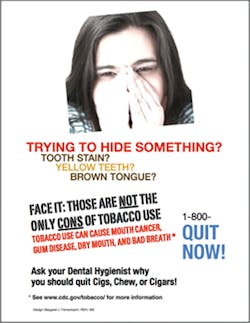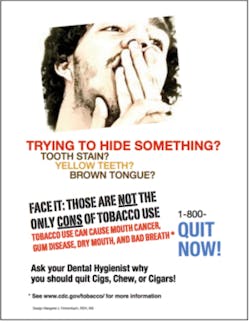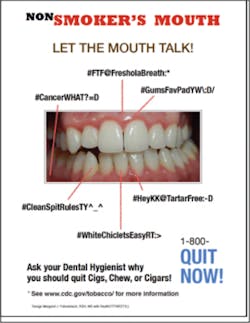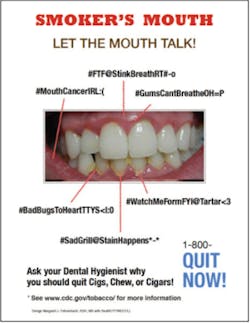Tobacco cessation posters for dental hygienists
Targeting young tobacco users with posters that can be downloaded by a dental office
BY Margaret J. Fehrenbach, RDH, MS
The population of young adults who smoke is still growing. Yes, there is an overall downward trend, but one in three young adults still reports using cigarettes.1 Every day, more than 1,200 people in this country die due to smoking. For each of those deaths, at least two young adults become regular smokers each day. Almost 90% of those replacement smokers smoke their first cigarette by age 18. In addition, it is sometimes very hard to reach these young adults only by discussion in the dental office, since that can be viewed as interfering with their lives. They want to appear as an independent adult making their own decisions and not seeking advice from older people who they view as already close to death.2
Prevention efforts must focus on young adults ages 18 through 25 since almost no one starts smoking after age 25. Shockingly, nearly nine out of 10 smokers started smoking by age 18, and 99% started by age 26. Sadly, progression from occasional to daily smoking almost always occurs by age 26.1
The scientific evidence is substantial and clear. Public education campaigns reduce the number of youths who start smoking, increase the number of smokers who quit, and make the tobacco industry's marketing less effective, saving lives and health-care dollars. The 2012 Report of the Surgeon General, Preventing Tobacco Use Among Youth and Young Adults, concluded specifically and unequivocally that mass media campaigns "prevent the initiation of tobacco use and reduce its prevalence among youth."3 Mass media campaigns that provide information about how to get help with quitting can be particularly effective in promoting quit attempts. The report also found that teens respond most to "ads that evoke strong negative emotions such as those that demonstrate how smoking … harm(s) health."
------------------------------------------------------------
For other articles about the effect of tobacco on oral health, please consider:
------------------------------------------------------------
With my background as both an oral biologist and working in tobacco cessation since the early 1980s, as well as working with the young adult population both in my private practices and as an instructor in the dental profession, I felt that I could try and reach this population through a strong media presentation such as a poster. I am passionate about tobacco cessation since my vibrant mother died of tobacco-related stroke; she started smoking to look "hip" in her late teens in New York City. And my loving father passed away from a secondhand tobacco related cancer (bladder), as noted on his death certificate.
Posters deliver consistent message
A poster placed in the dental operatory may easily be seen by this population when they visit the dental office. Importantly, this population is sometimes not directly seen by the dental hygienist but only the dentist for an examination and possibly polishing by the dental assistant. If the young smoker (or one that is considering smoking) is provoked by the message on the poster, they may consider looking at smoking as risky. Then there may be one less adult smoker we have to see for periodontal therapy as well as possibly saving their life overall!
In addition, I made the copyright free posters easy to download by the use of the portable document format (PDF) and inexpensively printed for use on an 8x11 inch paper to be put up right away in the dental operatory. A program on the computer (Pages, Apple) was used to create the posters. The four posters are located off my personal website along with other tobacco cessation resources such as YouTube and PowerPoint programs, as well as links for both patients and dental professionals (see www.dhed.net/Tobacco_Cessation.html).
My first step in the creation of the posters was to determine what type of campaign could reach the young adult smoker. Many posters and related media today are very graphic in their presentations. They often shock the smoker into a change; an example is the new media campaign aimed at young adults by the Food and Drug Administration (FDA). This can work in many settings such as community public health.4 Recently, the Centers for Disease Control (CDC) put out a specific page for dental professionals and included a background story of a past smoker with additional media presentations that used scare tactics.5 The woman is seen taking her denture out in front of a mirror from edentulism at age 50. But these types of campaigns may be considered too strong if used directly in the dental operatory; a slightly "softer approach" would be more effective.
Studies show that oral esthetics is seen as a powerful method for influencing young adults. A strong anti-tobacco message can start with young adults' desire for white teeth.6 Young adults are not known for their concern over future health effects that they are sure will never happen to them, so an esthetic approach would be more effective.7 It is important that "the poster needs to be relevant to your intended audience, and the information in it needs to be relevant to your stated purpose."8
My next step was to present information on the poster that is easily understood, covering the range of topics needed for the young adult to make a change in behavior or prevent a risky one from occurring. Thus, it is important that "the purpose needs to be clear to your audience. If your audience doesn't know what you are trying to communicate, they will lose interest." Changing more complex terminology involving the risk of smoking was imperative since there may not be discussion with a dental professional at the time of viewing the poster(s) by the young smoker (or one considering taking up the smoking habit). Accordingly, periodontal disease is now noted as "gum" disease. It is important to use vocabulary that your audience understands.7
Also included in the poster is the contact person in the dental office, the dental hygienist, as well as the website for the CDC for more information on quitting.9,10 With young adults, "traditional assistance in quitting for adults has not been shown to be that effective … such as referral to a quitline. A better approach would be to direct them to a quit website."11 However, even though studies indicate that most young adults would not call the quitline, I felt we should incorporate the national quitline number into the message for other groups that view the poster, just in case older adults were moved to action by the posters, creating a model of quitting!
The American Cancer Society marks the Great American Smokeout on the third Thursday of November each year by encouraging smokers to use the date to make a plan to quit, or to plan in advance and quit smoking that day. By quitting - even for one day - smokers will be taking an important step towards a healthier life, one that can lead to reducing cancer risk.
This year the Great American Smokeout will take place on November 20, 2014. Not only does the event challenge people to stop using tobacco, it helps to raise awareness about the dangers of smoking and the many effective ways available to quit smoking permanently.
My last step was to obtain the necessary graphics and permission to use them. This proved the most difficult for the posters using models. The young adults portrayed would be thought to be smokers by the viewers, and many online graphic licensees see this as "defamatory" behavior: "uses prohibited by licensees: use of an image together with pornographic, defamatory, or otherwise unlawful or immoral content or in such a manner that it infringes upon any third party's trademark or intellectual property."
An online graphic company, Wagging Dog Media Limited, London, UK (at www.freedigitalophotos.net), was finally found that would allow not only the use of the graphics in tobacco cessation posters but also not need any acknowledgement on the posters if purchasing the graphics. Permission was granted by email response as desired by the company since they do not want any direct contact with the licensees for the most part. After finally finding the graphic company, looking through hundreds of pictures of young adults, two models posing were found that would work into the overall concept.
Four posters have been created (see Figures 1, 2, 3, and 4), comprised of two sets. The first set shows a young adult female and also a young adult male. Both appear to be hiding their embarrassing stained teeth due to smoking as their picture is being taken with a hand-held device. But the emphasis in the message presented on the posters is that is embarrassment is not only what needs to be considered; they need to be concerned about risk of getting the more serious mouth (oral) cancer to the less serious dry mouth (xerostomia) from tobacco use. Importantly, it states to "Quit Now" in capital letters, which indicates a "shouting out" image by the viewer.12
The posters include not only cigarette use in the message but also chew (spit tobacco) or cigars, since both spit tobacco and cigars can be seen erroneously as having less impact by the smoker than cigarettes. In addition, use of multiple tobacco products, including cigarettes, cigars, and smokeless tobacco, is common among young adults. Rates of smokeless tobacco use are no longer declining and appear to be increasing among some groups. Cigars, especially cigarette-sized cigars, are popular with youth. One out of five male high school students smokes cigars, and cigar use appears to be increasing among other groups.8
It was decided to use a bold "street art" type of font type so that it would stand out against in the dental operatory and be easily related to by the young adult population. Use of primary colors was also used to catch the eye but adding yellow and brown as a color for the "stained" inference makes those words stand out. The use of active pose of the models - the young adult female and young adult male - also establishes the viewer to look at what each of the posters is saying: a picture is always worth a "thousand words."7 Making the photographs of the models used in the posters appear as pictures taken with a hand-held device with its somewhat grainy appearance also added to the freshness of the approach.
The second set of posters came about since I noticed all the trending on the use of Twitter language.13 Hopefully, the language that is so common now to young adults draws in the intended audience. I wanted to contrast a nonsmoker's mouth with that of a smoker's mouth and luckily found two contrasting copyright free clinical photographs.14 But I did not want an older mouth with excessive amount of periodontitis. I chose instead a view of gingivitis, again stressing the risk of tobacco use from less serious (bad breath) to more serious (heart problems). All the other elements of the first poster set as discussed were again included in this second set.
The first set of posters was presented during talks on tobacco cessation at three of local state dental hygiene schools' campuses. The posters received a positive response by the young adults who are becoming the next generation of dental hygienists. They felt that the posters mastered the thought process in the young adult and did not "turn them off." Instead, it made them look at the larger risks involved past the noticeably stained teeth. They had some good insights on how the models should look in the photographs and that they should include both a young adult male as well as female. In addition, one class evaluated the posters using a well-recommended poster evaluation checklist in order to help along this process.7 The second set has been featured in Facebook comments sections for dental hygiene related associations and received many "likes."
It is now hoped that these four posters created on tobacco cessation will be used by dental hygienists to be placed in the dental operatories of their private practices, as well as by the dental hygiene community at large. In addition, it hoped that this activity of poster creation helps make an impact in tobacco cessation in the young adult population so that there will be less adult smokers. It will be interesting over time to get feedback from those clinicians who use the posters and make any adjustment necessary to make sure the message is clear enough to the young adult viewer. Now if you have any ideas for future posters or other media blitzs to fuel tobacco cessation, feel free to discover them using the resources noted; creativity is not copyrighted!
Margaret J. Fehrenbach, RDH, MS, is an oral biologist and dental hygiene educational consultant. Margaret recently received the AC Fones Award from ADHA (2013) for her work in promoting local anesthesia for dental hygienists, such as "Local anesthesia for the Dental Hygienist" (Elsevier
, 2012) as well as the ADHA Award of Excellence (2009) for her textbook contributions. She is the primary author of the "Illustrated Anatomy of the Head and Neck" (Elsevier, ed 4, 2012) and "Illustrated Dental Embryology, Histology, and Anatomy" (Elsevier, ed 4, 2016) as well as a contributor to "Oral Pathology for Dental Hygienists" (Elsevier, ed 6, 2104) and editor of the "Dental Anatomy Coloring Book" (Elsevier, ed 2, 2013). Margaret has presented at ADEA, ADHA, and ADA Annual Sessions as well as Under One Roof for RDH Magazine. She is now involved in webinars and radio broadcasts as well as social media outlets. She can be contacted through her webpage at www.dhed.net.
REFERENCES
1. WebMD, Teen Health: Smoking. Accessed July 16, 2014 at http://teens.webmd.com/news/20120517/fewer-us-teens-and-young- adults-smoke
2. Popham, LE, et al. Ageism, sensation-seeking, and risk-taking behavior in young adults, Cur Psych 2011, 30:184-193.
3. HHS, Preventing Tobacco Use Among Youth and Young Adults, A Report of the Surgeon General, 2012. Accessed July 16, 2014 at http://www.surgeongeneral.gov/library/re ports/preventing-youth-tobacco-use/
4. Food and Drug Administration, FDA launches its first national public education campaign to prevent, reduce youth tobacco use. Accessed July 16, 2014 at http://www.fda.gov/News Events/Newsroom/PressAnnouncements/ucm384049.htm
5. Centers for Disease Control, Dental Professionals: Help Your Patients Quit Smoking. Accessed July 16, 2014 at http://www.cdc.gov/tobacco/campaign/tips/partners/health/dental/
6. Livestrong.com, Whitening for teens. Accessed on July 16, 2014 at http://www.livestrong.com/article/286862-whitening-for-teens/ (updated 2013)
7. Davis, JM. Active engagement a key in getting younger smokers to quit. RDH Mag 2011, June. Accessed July 16, 2014 at http://www.dentistryiq.com/articles/2011/06/younger- smokers.html
8. Health Sciences Library, University of North Carolina at Chapel Hill, Chapel Hill, NC. Designing effective posters. Accessed July 16, 2014 at http://guides.lib.unc.edu/posters
9. Centers for Disease Control, Tobacco & Smoking Use. Accessed July 16, 2014 at http://www.cdc.gov/Tobacco/
10. Centers for Disease Control, We Can Make the Next Generation Tobacco-Free. Accessed July 16, 2014 at http://www.cdc.gov/features/youthtobaccouse/
11. Sims TH. Quitline Cessation Counseling for Young Adult Smokers: A Randomized Clinical Trial. Nicotine Tob Res 2012, Oct 18. Accessed July 16, 2014 at http://www.ncbi.nlm.nih.gov/pmc/articles/PMC3621584/
12. Robb A. New Republic, How Capital Letters Became Internet Code for Yelling. Accessed July 16, 2014 at http://www.newrepublic.com/article/117390/netiquette-capitalization-how- caps-became-code-yelling
13. Twitter Inc., Twitter glossary. Accessed July 16, 2014 at https://support.twitter.com/articles/166337-the-twitter-glossary
14. Wikipedia, Gingivitis. Accessed July 16, 2014 at http://en.wikipedia.org/wiki/Gingivitis




